Isabella Bradford's Blog, page 58
April 21, 2016
Friday Video: Truly Vintage Denim: A Pair of 1840s Trousers
Isabella reporting,
The clothing that most Americans wear today has a short and dismal life - clothes that are cheaply made overseas, designed for today's fashion instead of longevity, and often discarded after a season or two. Some garments don't even last that long, doomed by shoddy construction and inferior fabric. It's the modern curse of Fast Fashion.
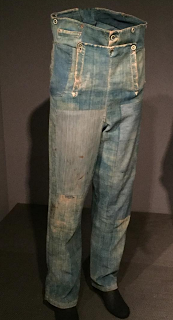
These trousers are something else entirely. They've not only had a long, long life; they've acquired a soul, too, and they just might be the great-grandfather of our modern jeans. Curators guess that they were made about 1840, before sewing machines, and all the seams are stitched entirely by hand. But that's only the beginning of the evolution of these trousers, as this short video explains.
The trousers are featured in the Denim: Fashion's Frontier exhibition currently on display at the Museum of FIT, New York. It's a fascinating, thoughtful show (you can see more highlights here ) and if you're in New York, you should see it. But hurry: it closes on May 7, 2016.
Many thanks to Nicole Bloomfield, conservator at the Museum of FIT for suggesting this video.
Published on April 21, 2016 21:00
Friday Video: Truly Vintage Denim: A Pair of 1840s Pants
Isabella reporting,
The clothing that most Americans wear today has a short and dismal life - clothes that are cheaply made overseas, designed for today's fashion instead of longevity, and often discarded after a season or two. Some garments don't even last that long, doomed by shoddy construction and inferior fabric. It's the modern curse of Fast Fashion.

These trousers are something else entirely. They've not only had a long, long life; they've acquired a soul, too, and they just might be the great-grandfather of our modern jeans. Curators guess that they were made about 1840, before sewing machines, and all the seams are stitched entirely by hand. But that's only the beginning of the evolution of these trousers, as this short video explains.
The trousers are featured in the Denim: Fashion's Frontier exhibition currently on display at the Museum of FIT, New York. It's a fascinating, thoughtful show (you can see more highlights here ) and if you're in New York, you should see it. But hurry: it closes on May 7, 2016.
Many thanks to Nicole Bloomfield, conservator at the Museum of FIT for suggesting this video.
Published on April 21, 2016 21:00
April 20, 2016
Queen Elizabeth II Turns 90
 Loretta reports:
Loretta reports:Today is Queen Elizabeth II’s 90th birthday. She is the longest-reigning British monarch, surpassing Queen Victoria as of last September. Though she isn’t our queen, we Yanks find her interesting for all kinds of reasons. Certainly many of us love the pageantry associated with royals, the palaces, the golden coaches, the ancient rituals.
I’m deeply interested because the monarchy is the heart of that world of noble men and women who people my fiction. The court, those who make up the upper ranks of society, how one addresses this person, who’s a peer and who isn’t, who inherits what—learning about and trying to execute correctly these and numerous other mysteries of a completely foreign world, are part of the torture and joy of what I do.
But the royals I study are long gone. Queen Elizabeth is one of a vanishing breed. She's the living model of a monarch, the modern version, yes, apparently much saner than some of her ancestors; and there she is, on TV, still doing her Queen thing, as she’s done my whole life, with dignity and grace and what seems to be good humor.
So I thought we'd mark her milestone birthday with this set of photos of her life.
Readers who receive our blog via email might see a rectangle, square, or nothing where the video ought to be. To watch the video, please click on the title to this post.
Published on April 20, 2016 21:30
April 18, 2016
At a Police Office, 1828
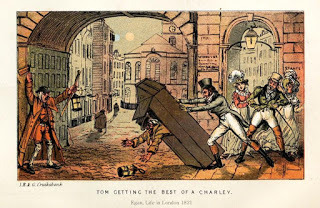 Tom Getting the Best of a Charley
Loretta reports:
Tom Getting the Best of a Charley
Loretta reports:A gentleman, summoned by a friend who got caught in a police raid on a gambling establishment, recounts his first experience there. I’ve excerpted only the account of the “young sparks” who decided to copy one famous scene from Life in London and ended up experiencing another—a visit to Bow Street.
LIFE AT A POLICE OFFICE.
I was awakened a short time back by a note being delivered to me from a young friend of mine, telling me that he was in trouble—i.e., in St. Martin's watch-house—and requesting me to come down to Bow-street to be his bail, if need were; and, at all events, to give him my advice and assistance to get out of the scrape. ...
This was the first time I had ever been at Bow-street, and the scene was sufficiently striking. The low ill-lighted room, with its dingy walls and barred windows, was a place well adapted to the figures of want, vice, and wretchedness with which it was filled. ...
After [a young forger] were brought up three young sparks for a street row. They had been enacting the parts of Tom, Jerry, and Logic, and the scene had ended, as usual, in the watchhouse. One of them exhibited the marks of the prowess of the "Charlies" in a eye portentously swollen and blackened. The two others seemed to have undergone complete immersion in the kennel; the mud of which, being now dried on their clothes, gave their evening finery a most dilapidated aspect. It appeared that these young men had been vastly taken with the refined humour, brilliant wit, and gentlemanly knowledge of the world in the production called " Life in London;" and that they had determined to emulate the deeds of its triumvirate of worthies as soon as opportunity served. In pursuance of this exalted ambition, they had sallied forth the night before with the determination of having " a spree." Accordingly, in the Strand, they had overtaken a watchman, a feeble old man, who was instantly, in the most manly manner, floored by a broad-shouldered young fellow of six feet high. The prostrate Charley, however, incontinently sprang his rattle, which brought to his assistance a sufficient number of his brethren to lodge, after a desperate resistance, the Corinthian and his friends in the watch-house. And here it appeared that their-behaviour was by no means peaceable and resigned; indeed, the constable averred, that be was finally necessitated to consign them to the strong room for safety.Tom & Jerry In Trouble After a Spree
"At length the morn and cool reflection came,"
and found our heroes " fully sated" with their manly and gentlemanly exploit, and still more so with its consequences. These, however, terminated only at Bow-street; for, besides large pecuniary remuneration to make to the persons whom they had assaulted, they underwent a most severe and well-deserved rebuke from the magistrate for their folly, brutality, and blackguardism.—Gentleman’s Pocket Magazine 1828
Published on April 18, 2016 21:30
Breakfast Links: Week of May 2, 2016
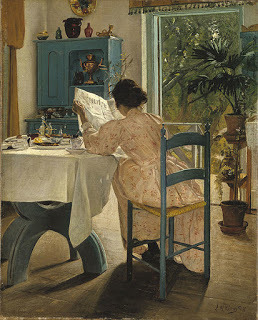 Breakfast Links are served - our weekly round-up of fav links to other web sites, articles, blogs, and images via Twitter.
Breakfast Links are served - our weekly round-up of fav links to other web sites, articles, blogs, and images via Twitter.• William the Conquerer' s struggle to win London.
• How a 17thc woman became the toughest man in the Spanish army.
• Members of Parliament and Queen Victoria's coronation .
• Heartbreaking notes attached to babies left at the New York Foundling Hospital.
• Controlled substances in Roman law and pharmacy.
• Image: Powerful photo of Susan B. Anthony's grave with "I Voted" stickers left by women on day of New York primary.
• Intricate knitted silk and linen lace shawl given to Harriet Tubman by Queen Victoria.
• Regency road accidents , 1816.
• Does the Library of Congress hold a British scouting map of Lexington & Concord in 1775?
• The fad for veils woven with bees, snakes, and spiders, 1911.
• Image: "Let the men wash."
• How to knit like the Brontes .
• A raging letter to a 1798 editor on the state of contemporary fashion - and Johnny Gilpin.
• The weaker sex? Violence and the suffragette movement .
• We can't help ourselves: why your brain loves procrastination.
• West meets East: the early days of Chinese restaurants in America, 1896-1926.
• Image: The first letter sent by Princess Elizabeth as a girl to her grandmother.
• Listen, my children, and you shall hear, of the midnight ride of... Isaac Bissell ?
• A filthy history: when New Yorkers lived knee-deep in trash .
• Where your education takes you: how a University of Pennsylvania scholar advised metal legend Iron Maiden .
• Mad dogs of London: an 18thc tale of rabies .
• From women's petticoats to artists' lofts: the many lives of a NYC factory building.
• Image: Cartwheeling and tumbling from the University of Iowa Department of Physical Educations for Women.
• The 18thc mystery of Oliver Cromwell's missing head .
• Forgery and banknotes during the American Revolution.
• The tiny 19thc dolls called Frozen Charlottes : there's a corpse in your birthday cake!
• Early 19thc bicycling fashions .
• Clarissa Penn's silk quilt , made of wedding and "second day" dresses, 1840-1860.
• The now-lost " house of flowers " on New York's Fifth Avenue.
Hungry for more? Follow us on Twitter @2nerdyhistgirls for fresh updates daily.
Above: At Breakfast by Laurits Andersen Ring. Private collection.
Published on April 18, 2016 11:50
April 17, 2016
An Artist in Revolutionary France: Élisabeth Vigée Le Brun (1755-1842)
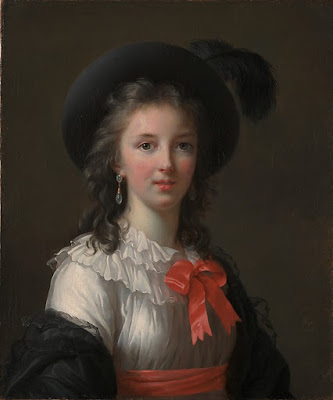 Isabella reporting,
Isabella reporting,Last week I saw a wonderful show of 18thc portraits at the Metropolitan Museum of Art, an exhibition devoted to the work of a single, highly successful artist. Such an exhibition would be common enough if the artist were Sir Joshua Reynolds, Thomas Gainsborough, Jean-Honoré Fragonard, or any of the other prominent male painters of the era. But what made this exhibition unusual was that the featured artist was a woman - Élisabeth Vigée Le Brun – and that despite her talent and success, this is the first retrospective of her work in modern times.
Vigée Le Brun: An Artist in Revolutionary France (on view now through May 15, 2016) includes more than 75 of the artist's works. Included are the portraits that made her one of the most important artists of her time. Born into a family of artists, she was painting professionally as a teenager; only her marriage at twenty-one in 1776 to the leading art dealer in Paris kept her from being accepted into the Académie Royale de Peinture et de Sculpture.
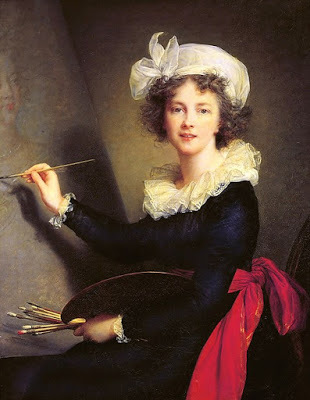
However, Mme. Vigée Le Brun's work had already attracted the attention of Queen Marie Antoinette. She painted her first official portrait of the queen in 1778, and as court painter, she went on to paint more than thirty more of Marie Antoinette and the royal family. With the queen's patronage - and pressure - Mme. Vigée Le Brun was finally admitted to the Académie in 1783, where she was one of only four women members. Her portraits became in great demand at the French court, and she painted both celebrated beauties and powerful nobles.
But as revolution loomed, the queen's patronage proved more of a danger than a benefit. To avoid arrest, Mme. Vigée Le Brun fled France with her young daughter Julie (she had separated from her husband) in 1789, and took her talents to other cities and royal courts across Europe. It was a perilous time for travel, especially for a woman, yet Mme. Vigée Le Brun's commissions led her to Florence, Naples, Vienna, Berlin, London, and St. Petersburg. As the political climate again changed in Paris, she was finally permitted to return to France during the reign of Napoleon I. Although her style gradually fell from artistic fashion, she continued painting until her death in Paris in 1842.
Her memoirs, first published in 1835, are often quoted in the captions of the Met's exhibition. Not only do they reveal her talent for maneuvering through the Parisian art world, but also show an equally important skill for a portraitist: the ability always to find something favorable to say about her sitters.
Her sensitivity and sympathy show in her portraits, and it's much of what makes them still so appealing today. I've chosen to illustrate this post with a selection of Mme. Vigée Le Brun's self-portraits, and she presents herself not only as an attractive, successful woman, but also as an approachable and charming one, her lips always slightly parted in a smile. Sitting for her must have been a pleasure in every sense.
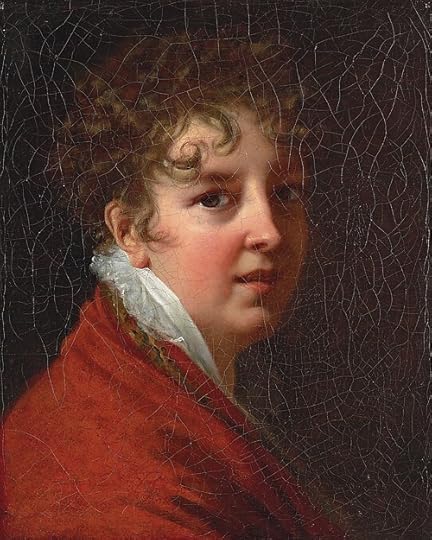 While I know most of you won't be able to travel to New York to see the exhibition in person (and I share your pain every time I hear of a must-see show in London or Los Angeles!), the Met has generously put all eighty works on line
here
.
While I know most of you won't be able to travel to New York to see the exhibition in person (and I share your pain every time I hear of a must-see show in London or Los Angeles!), the Met has generously put all eighty works on line
here
.Above left: Self-Portrait with Cerise Ribbons by Élisabeth Vigée Le Brun, c1782, Kimbell Art Museum.
Right: Self-Portrait by Élisabeth Vigée Le Brun, 1790, Gallerie degli Uffizi.
Lower left: Self-Portrait by Élisabeth Vigée Le Brun, c1808, private collection
Published on April 17, 2016 18:13
April 16, 2016
Breakfast Links: Week of April 11, 2016
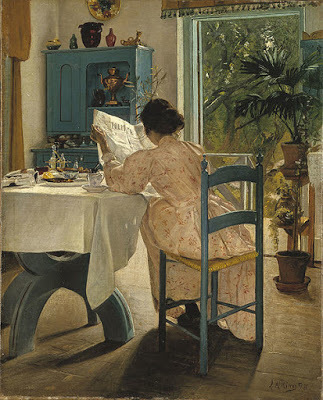 Breakfast Links are served - our weekly round-up of fav links to other web sites, articles, blogs, and images via Twitter.
Breakfast Links are served - our weekly round-up of fav links to other web sites, articles, blogs, and images via Twitter.• Behind the music: the story of a rare and beautiful three-piece man's court suit .
• Conde Nast to release thousands of unpublished fashion photographs from its archives of Vogue and Vanity Fair.
• The hidden history of maps made by women.
• Why slaves' graves matter.
• Women's work : depictions of idealized women and labor on paper currency.
• The amazing story of Dorothy Levitt , holder of the world's first water speed record.
• Image: Now this is a regal signature - zoom into see the signature of Elizabeth I.
• Midwives , abortion, and the Offenses Against the Person Act of 1861.
• You don't want to know: the mystery of " French kid " gloves, 1858.
• Microbiologists find Hannibal's route through the Alps, a crossing made 2,000 years ago.
• Joseph Crouch: "a Body Snatcher since a child."
• After 36 years of hunting, archivists finally found the Wright Brothers' airplane patent.
• Marbled madness.
• The mysterious Thelma X and the struggle of black domestic workers.
• Image: "The Dinner Horn " a wood engraving by illustrator and artist Winslow Homer.
• • At the center of a difficult and contested marriage: Ingeborg of Denmark, a 12thc Queen of France.
• Photographs of a vanishing world: the disappearing post offices of the rural South.
• Graves with a view: exploring the picturesque burial grounds of the Isle of Mull.
• New insight into Shakespeare's life revealed through scientific analysis of his will.
• Image: From 1874: train schedules were much more complicated to decipher before time was standardized.
• A favorite topic of ours: Queen Victoria was NOT the first bride to wear white.
• The English earthquake of 1580 had a moral and religious dimension that far outweighed the damage it caused.
• The peculiar history of celebrity dolls.
• Poisons, potions, and charms in Shakespeare's plays.
Hungry for more? Follow us on Twitter @2nerdyhistgirls for fresh updates daily.
Above: At Breakfast by Laurits Andersen Ring. Private collection.
Published on April 16, 2016 14:00
April 14, 2016
Friday Video: Unfolding an 18thc Gaming Table
Isabella reporting,
For most of us today, furniture doesn't get much more complicated than assembling an Ikea bookcase. But for the cabinetmakers of 18thc Europe, furniture became the highest expression of art, engineering, and ingenuity combined. This gaming table was created by the famed German cabinetmaker David Roentgen (1743-1807) for a wealthy client; furniture like this was prized by the elite classes of the Age of Enlightenment. Featured in this video from the Metropolitan Museum of Art, this gaming table was not only an exquisite piece of art with beautifully carved and inlaid wood, but also a cleverly adaptable and useful piece of furniture.
If you received this post via email, you may be seeing an empty space or black box where the video should be. Please click here to view the video.
Published on April 14, 2016 21:00
April 13, 2016
Lalique Necklace for the 1890s
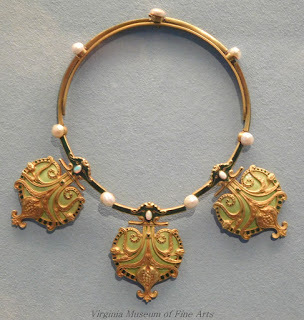
Loretta reports:
René Lalique might be familiar to most of us for his beautiful glass work. However, as we’ve shown before , this artist designed jewelry to the same high standard.
I’ve visited the Virginia Museum of Fine Arts several times, and wandered in a sort of ecstatic trance through the Art Nouveau and Art Deco collection. But the museum offers so much that I can always count on finding a remarkable something I somehow overlooked or hadn't time to study previously.
This ca. 1897 Lalique necklace, one of numerous stunning gifts from Sydney and Frances Lewis ,
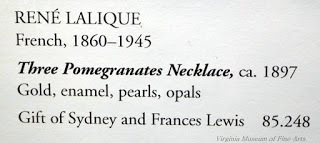
is late 19th century (earlier than the collar linked to above). I think it’s a wonderful example of the work created during the Belle Époque .
Here again is the Art Nouveau emphasis on natural forms, with a rather sparing use of gemstones—emphasis on art and design, in other words, rather than sparkle. It may also owe something to ancient styles of jewelry I’ve seen in museums—it reminded me of necklaces found in ancient Egyptian tombs.
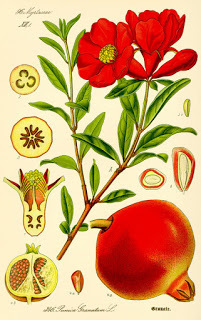 Pomegranate
Pomegranate
You can see a sharper image, and zoom in, here, on the museum website .
For more on Lalique, you might want to check out this past exhibition at the Corning Museum .
Necklace & description card photographed by me.
Botanical print of pomegranate from Prof. Dr. Otto Wilhelm Thomé Flora von Deutschland, Österreich und der Schweiz, 1885, Gera, Germany via Wikipedia.
Clicking on the image will enlarge it. Clicking on the caption will take you to the source, where you can learn more and enlarge images as needed.
Published on April 13, 2016 21:30
April 11, 2016
From the Archives: Bird Millman, Bewitching High Wire Artiste
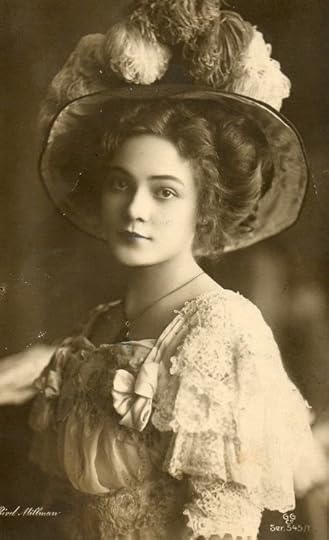 Isabella reporting,
Isabella reporting,Since I'll be traveling over the next few days, I'm sharing one of my favorite posts from the past featuring an intrepid - and daring - woman....
One of our recent Friday Videos featuring an unidentified woman dancing along a precariously high-wire far above the streets of an equally unidentified city. Our astute Nerdy History readers were quickly able to spot the buildings in the background and identify the city as New York. Some readers also thought the video was a clever fake, filmed before a backdrop, but thanks to one – Elise Daniel – we now know that the film was very likely real, and the name of the high-wire artist in the sky: Bird Millman O'Day.
Or maybe not. Read on!
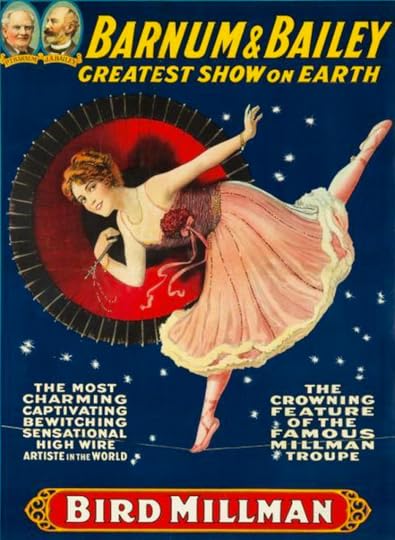
A hundred years ago, we all would have recognized her. Bird Millman (1890-1940) was one of the most celebrated performers of her time, a favorite of circus audiences around the world. Born Jennadean Engleman in Canon City, CO, she began her career as a precocious child performer, and worked her way up from small-town traveling circuses to the big-time vaudeville circuit, playing to packed houses in around America.
In 1913, she signed with the Barnum & Bailey Circus, right, and became a center-ring performer and major attraction, both with Barnum & Bailey and with the Ringling Brothers. In the off-season, she continued to play on Broadway as a featured star in the Ziegfeld Follies and Frolics, and toured Europe as well, where she famously gave a command performance for Kaiser Wilheim II.
"Every girl aught to walk a tightrope," Bird declared to the Milwaukee News in 1913. "It develops a rare set of muscles and self-confidence and teaches one how to walk properly on the street."
She was famous not only for her daring, but for making her performances look graceful and deceptively easy, with a light-hearted personality that charmed audiences. She was compared to a dainty bird (which gave her her theatrical nickname) and a fairy, and while most female circus performers wore provocatively close-fitting and skimpy (for the time!) costumes, hers featuring flowing, feather-trimmed skirts that made her look even more ethereal.
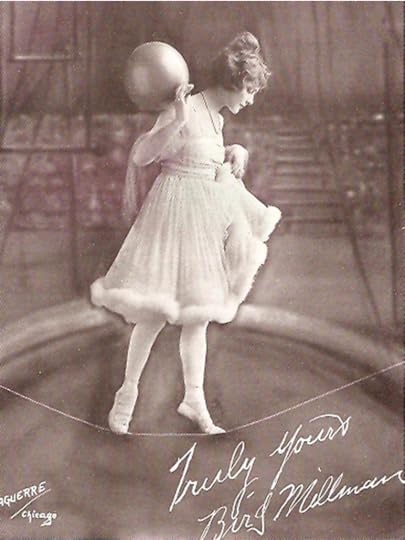
Sadly, while her public persona was that of a merry sprite, her private life was not as carefree. Her first two marriages were short-lived and ended in divorce. Her third marriage to Joseph Francis O'Day sounds like a Jazz Age match in a short story by F.Scott Fitzgerald: the high-wire dancer and the Harvard-educated millionaire. Bird happily retired from performing, determined to make this marriage work.
But O'Day lost his entire fortune - and Bird's - in the stock market crash of 1929. He died shortly afterwards, and the devastated and now-destitute Bird returned to Colorado to live with family. Her health deteriorated, and she died in great pain from uterine cancer in 1940, shortly before her fiftieth birthday.
Learning all this, however, only raises more questions about the silent film clip. British Pathe, which owns the film, has it catalogued as 1931 - which would have been years after Bird retired from performing.
However, soon after the U.S. entered World War One in 1917, Bird had indeed made a special patriotic performance in New York to help raise support for the war effort and for a Liberty Loan drive. She danced along a high-wire strung twenty-five stories over the Broadway where she was a star, and, according the newspaper reports, drew crowds and stopped traffic. I wonder if this performance is the one shown in the film. In one scene, she is shown with the Woolworth Building (the tall, angular skyscraper, identified by reader Thane Floreth) in the background, a scene that is also depicted on the cover of Popular Mechanics magazine.
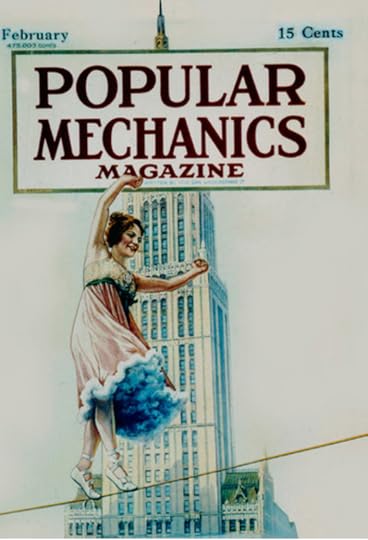
But if this film features a performer as well-known as Bird, then why wasn't she identified on the caption-cards? Was it old footage, recycled in 1931, and was her fame already so diminished that the filmmaker didn't bother to identify her? Or was this a recreation of Bird's famous feat by an unknown performer and using camera trickery? As another reader, Karen Anne, pointed out, no one on the ground is looking up - which would hardly be the case for the original well-publicized stunt.
So, readers: what do you think?
Top left: Bird Millman, c. 1905, Cannon City Historical Society.
Top right: Barnum & Bailey Circus poster, c. 1915.
Lower left: Autographed publicity photograph of Bird Millman, c. 1920, The Blondin Memorial Trust.
Lower right: Cover, Popular Mechanics magazine, July, 1917.
Published on April 11, 2016 21:00



